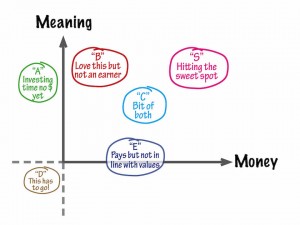At the end of last week I spent 3 days engrossed in intensive ANS planning for 2018. As you can probably imagine these planning days are incredibly exciting, creative, stimulating processes. If everyone involved had brain PET scans performed during these discussions, I think the disco lighting effect in our results would be noteworthy (!) and distinctly different from the stimulation that comes from most of our other work pursuits. Does anyone do disco all the time though? Not many of us. This prompted me to reflect back on a little graph I drew for myself this last month – that depicts the various ways all my different forms of work & how they contribute either money or meaning, or better still both!
Diversification of income streams is a key business catch cry, right?
And this is especially pertinent to clinicians.
But work variety may also be important in meeting our multiple values and need for meaningful engagement.
My varied work landscape (from private practise to corporate health report writing and many many things beyond & in between) was driven primarily by my own thirst for variety and inability to sit still, some might say 😉 Once you start diversifying, breaking from the 1:1 model, saying yes to myriad opportunities that are perhaps a little tangential, there is of course also a potential risk: fragmentation, loss of focus & dilution, overwhelm, doing nothing well, and a net sense of reduced rather than increased satisfaction. So it’s important to keep critically reviewing your choices of what work avenues you pursue and as part of that try and keep an eye on the balance between money and meaning.
Like most practitioners, some work I take on primarily based on ‘meaning’, because it ‘feeds my soul’ (ie. the ANS!!) and others I choose to do for ‘money’, because it ‘feeds my family’. Ideal, of course, is to seek out, identify and develop those opportunities that deliver both at a good level. But none of our worlds are made only of this. There is in fact work that all of us take on that may actually cost us or that we take on in spite of it being at odds with our values because these particular negatives are offset by other gains. To get overall perspective, it may be helpful to do up a little graph for yourself like I did and check the overall balance of the graph, right? When I did this, it helped to really clarify things for me & named a couple of projects that I need to leave behind.
A bimonthly work-streams stocktake? But rather than just some vague fuzzy thinking on this that you squeeze in between clients, it’s important to take some time and use a conceptual framework to visually document, sift through, review and reprioritise – there are probably lots of sophisticated ways to achieve this but I thought I would share something simple that worked for me on a morning of overwhelm and of feeling at cross-purposes. Bingo, Clarity.
Did you know Rachel also offers Individual Mentoring? Some practitioners find that this is the best fit for their learning style and the most efficient way to get their questions answered. Many of these practitioners have this scheduled at a regular time monthly, while others use this service on an as-need basis. If this is something you’re interested you can either book yourself directly into Rachel’s mentoring calendar at a time that suits you or we can schedule a regular session for you, just email your inquiry to [email protected].

